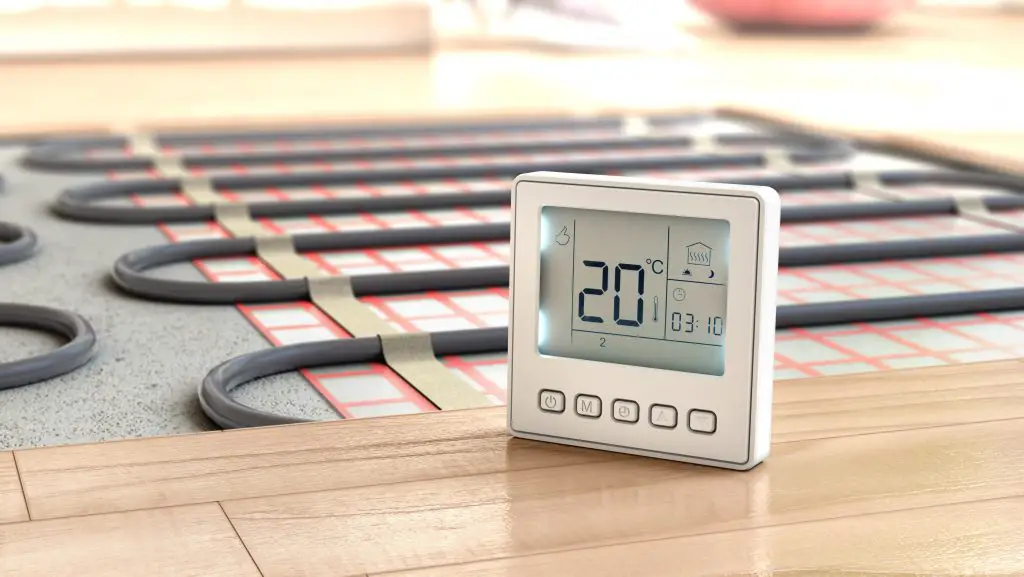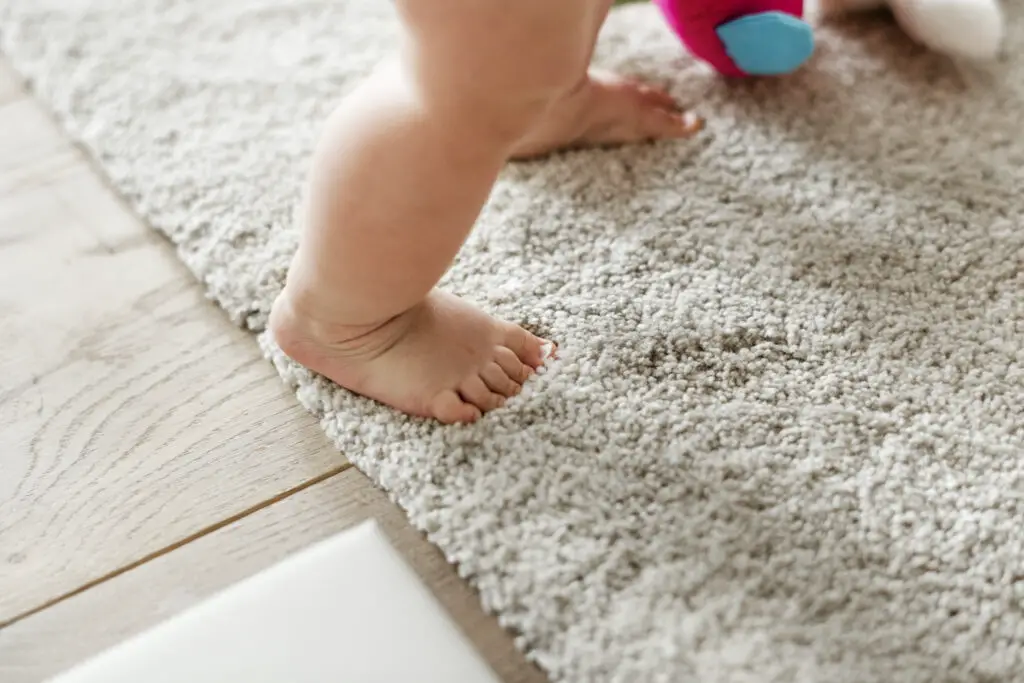Underfloor heating systems are very efficient and user-friendly, but certain steps must be carried out before turning them on for the first time after installation. This is to prevent failure even before the system starts functioning.
Before switching on the underfloor heating system for the first time, one must ensure that the adhesive used for the floor covering has properly cured. On average, it takes at least 7-14 days after installing the floor covering before the underfloor heating systems can be switched on.
The heat introduced to the floor would be at the lowest setting and then increased gradually.
After introducing heat to the floor, it should be increased gradually(by 1°C daily) until it gets to an acceptable level of warmth that is less than the threshold temperature for the floor finishing. The rest of this article will cover in detail the necessary steps to be taken into consideration before switching on underfloor heating.

How long should you wait to use your new underfloor heating?
A lot of people usually ask when they can start using their new underfloor heating system after installation. You might be eager to start warming your floors immediately, which makes waiting a little longer a bit hard. However, it’s best to wait so that the mortar can fully get cured. Waiting may not be necessary for products that don’t need mortar to install.
Here are some things to consider for products that require mortar to install:
Curing Times Vary
Activating the underfloor heating before the mortar is cured can cause compound failure. It can also damage the new flooring. Curing times vary because factors like chemical composition, the thickness of the mortar bed, humidity, and temperature can affect curing time. In general, the mortar setting time is usually between 3 to 28 days, depending on the mortar.
Problems with Early Activation
Early activation of the underfloor heating can cause the grout to not adhere properly or crack. This can void the warranty of the mortar you use. The importance of letting the mortar cure completely cannot be overemphasized.
Some professionals believe that activating the heating system earlier will make the mortar stronger and cure faster. One thing you should note every underfloor heating system manufacturer states the ideal time to wait before activating the system.

How soon can I use underfloor heating after tiling?
After tiling, it is best to wait for at least 7 days before using your underfloor heating system. Even after waiting for at least 7 days, it is best to start at the lowest temperature before increasing gradually. This is to ensure that the tile has enough time to set and cure properly before heat is applied.
There are factors to consider when turning the underfloor heating system for the first time. This is to ensure that the system functions properly.
Drying Time of Adhesive
Before you turn on the underfloor heating for the first time, you must follow the screed or adhesive company’s instructions for dying time. It is important that the adhesive sets properly to prevent them from cracking. Most manufacturers offer fast drying screed to ensure that the setting time of the screed is reduced.
Type of Flooring
The type of flooring is also important to consider before you turn on the underfloor heating for the first time. When you use flooring like laminate, you can turn on the underfloor heating system as soon as possible. However, it is best to give it time to settle for engineered and wooden floorings so that it doesn’t move or warp.
For tiles and solid flooring, extra time will be required to allow the adhesive to dry properly, this is due to the type of adhesive and leveling compound used when installing them. The vinyl and LVT type of flooring also require extended drying periods before the underfloor heating system is turned on. It is also necessary to check the manufacturer’s requirements when installing the various floor type.

What should I do before turning on my new underfloor heating?
Did you just get new underfloor heating installed? Here are some of the things the installer must have done before you turning on the underfloor heating:
The installer should first fix the insulation boards to the sub-flooring. This is important for an electric underfloor heating system. Fixing the insulation boards will help to prevent heat from escaping download. For wooden or timber floors, the insulation boards can be drilled, while adhesive can be used to fix insulation boards on concrete floors. Another thing to ensure for electric underfloor heating is that the power supply can be fitted with ease.
For wet underfloor heating, it is important to ensure that the sub-flooring should be clear of debris. This will ensure that the insulation board is properly fitted. Doing this will not only reduce heat loss but will also increase heat efficiency. Another important thing is the location of the manifold. It is important to ensure that the manifold is suitably located.
What happens if I turn on my underfloor heating too early?
Turning on underfloor heating too early can cause a problem, especially when the mortar hasn’t cured completely. This can cause cracks on the grouts or even prevent them from adhering properly. Depending on the type of adhesive you use, you will need to give it time to cure and set. Turning on the underfloor heating too early will prevent this from happening and can cause the adhesive to break.
Even after you have left the adhesive to dry properly, it is not advisable to start with high temperatures. Start with a very low temperature before you gradually increase it to your desired temperature. All of this is to ensure that you do not affect the adhesive, as well as the mortar.
How long does the Underfloor heating system take to warm up?
After successfully turning on the system for the first time, subsequent heating times usually take between 30mins to several hours before it can get to a substantial heating temperature. It is usually advised that the systems should not be switched off due to the amount of time taken for it to get to a considerable warm temperature, instead the temperature should just be placed at the minimum.
The time taken for this system to heat up is dependent on the following factors, they include:
- Floor Finishing: Tiles and concrete floors would easily absorb heat, and distribute it. Carpets, wood floors do not distribute heat like concrete floors, and this may lead to an increase in time taken for heating up.
- Level of insulation: The level of insulation plays a huge role in heating floors. In cases where the floor is not well insulated, the heat generated could seep into the ground, hence reducing the amount of heat that gets to the topmost layer of the floor. Also, if the house is not well insulated, the heat generated would escape from the available spaces in the house.
- Ambient temperature: Air Source heat pumps struggle to generate enough heat on days when there is a fluctuation in air temperature and this can increase the time taken for the system to heat up. Ground source heat pumps also struggle when the floor temperatures drop drastically, this causes the system to struggle to achieve maximum heat output.
Other factors include floor construction, type of substrate, amount of heat loss.

Conclusion – When can I turn my Underfloor heating on?
There are so many factors to consider before you turn on your new underfloor heating. You need to know the type of flooring you are using and ensure that the adhesive dries properly. The aim is to prevent cracks that may be caused by excessive heat.
In general, most adhesives take between 7 and 28 days to be fully cured. However, this depends on the thickness of the adhesive used. If you are not sure of the curing time, you can contact the manufacturer or check the manufactures manual for the ideal curing time.
The bottom line is that if the underfloor heating is switched early, it can cause the adhesive to dry faster, thereby leading to cracking. You don’t want this to happen.
Lots more Underfloor Heating Information Here
- What Depth is Required for Underfloor Heating?
- Turning on Underfloor Heating for the First Time – How Long to Wait?
- Can you lay Vinyl flooring over underfloor heating?
- Do Tiles Crack With Underfloor Heating?
- Can You Heat a Whole House With Underfloor Heating?
- Can You Have Underfloor Heating Upstairs?
- Will Underfloor Heating Raise My Floor? – Underfloor Heating Layers Explained
- Can I put furniture on top of underfloor heating?
- How Do I Know If My Underfloor Heating is Leaking?
- Can You Combine Underfloor Heating With a Ground Source Heat Pump?
- Is Underfloor Heating Safe?
- Does Underfloor Heating Add Value to a Property?
- Can you have Wooden Floors with Underfloor Heating?
- Can Underfloor Heating Cause a Fire?
- What temperature should Underfloor Heating be set at?
- Can I Put a Rug Over Underfloor Heating?
- How Long Does it Take for Underfloor Heating to Warm Up?
- Why is my Underfloor Heating Noisy?
- Why is my Underfloor Heating Patchy?
- How do I know if My Underfloor Heating is Working? – Common Problems & Fixes
- What can go wrong with underfloor heating?
- Can you Combine Underfloor Heating with an Air Source Heat Pump?
- Do you keep underfloor heating on all the time?
- Does Underfloor Heating work with Smart Thermostats?
- Kitchen Underfloor Heating – Should Underfloor Heating go Under Kitchen Units?
- How much energy does Underfloor Heating use?
- Underfloor Heating in Summer and Winter
- Lifespan of Underfloor Heating
